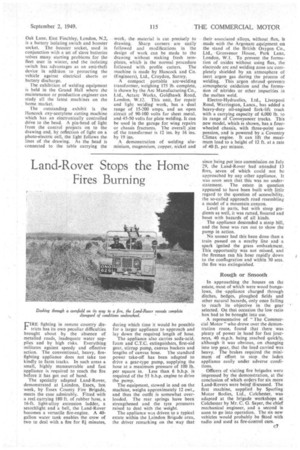Land-Rover Stops the Home
Page 45

If you've noticed an error in this article please click here to report it so we can fix it.
Fires Burning
FIRE fighting in remote country districts has its own peculiar difficulties brought about by the absence of metalled roads' inadequate water supplies and by high risks. Everything militates against speedy and effective action. The conventional, heavy, firefighting appliance does not take too kindly to farm tracks. In such areas a small, highly manceuvrable and fast appliance is required to reach the fire before it has got out of hand.
The specially adapted Land-Rover, demonstrated at Laindon, Essex, last week, by Essex County Fire Brigade, meets the case admirably. Fitted with a reel carrying 180 ft. of rubber hose, a 16-ft. light-alloy extension ladder, a searchlight and a bell, the Land-Rover becomes a versatile fire-engine. A 4(1gallon water tank enables the crew of two to deal with a fire for 81 minutes, during which time it would be possible for a larger appliance to approach and lay down the required length of hose.
The appliance also carries soda-acid, foam and C.T.C. extinguishers, first-aid gear, stirrup pump, canvas buckets and lengths of canvas hose. The standard power take-off has been adapted to drive a gear-type pump, supplying the hose at a maximum pressure of 100 lb. per square in. Less than 6 b.h.p. is required of the 55 b.h.p. engine to drive the pump.
The equipment, stowed in and on the machine, weighs approximately 12 cwt., and thus the outfit is somewhat overloaded. The rear springs have been strengthened and the tyre pressures raised to deal with the weight.
The appliance was driven to a typical estate within the Laindon Brigade area, the driver remarking on the way that since being put into commission on July 29, the Land-Rover had attended 13 fires, seven of which could not be approached by any other appliance. It was soon seen that this was no understatement. The estate in question appeared to have been built with little regard to the question of accessibility, the so-called approach road resembling a model of a mountain canyon.
Level in parts, but with steep gradients as well, it was rutted, fissured and beset with hazards of all kinds.
The appliance descended a steep hill, and the hose was run out to show the pump in action.
No sooner had this been done than a train passed on a nearby line and a spark ignited the grass embankment. This opportunity was not missed, and the fireman ran his hose rapidly down to the conflagration and within 30 secs. the fire was extinguished.
Rough or Smooth In approaching the houses on the estate, most of which were wood bungalows, the -appliance charged through ditches, hedges, ploughed fields and other natural hazards, only once failing to .reach its objective in the gear selected. On that occasion the low ratio box had to be brought into use.
A representative of "The Commercial Motor" who drove over the demontration route, found that there was plenty of power in hand for fast journeys, 40 m.p.h. being reached quickly, although it was obvious, on changing into top gear, that the load carried was heavy. The brakes required the minimum of effort to stop the laden appliance easily under adverse conditions.
Officers of visiting fire brigades were impressed by the demonstration, at the conclusion of which orders for six more Land-Rovers were beinf discussed. The first machine, supplied by Spurting Motor Bodies, Ltd., Colchester, was adapted at the brigade workshops at Colchester by Mr. C. G. Sayer, the chief mechanical engineer, and a second is soon to go into operation. The six new vehicles would probably be fitted with radio and used as fire-control cars.




























































































